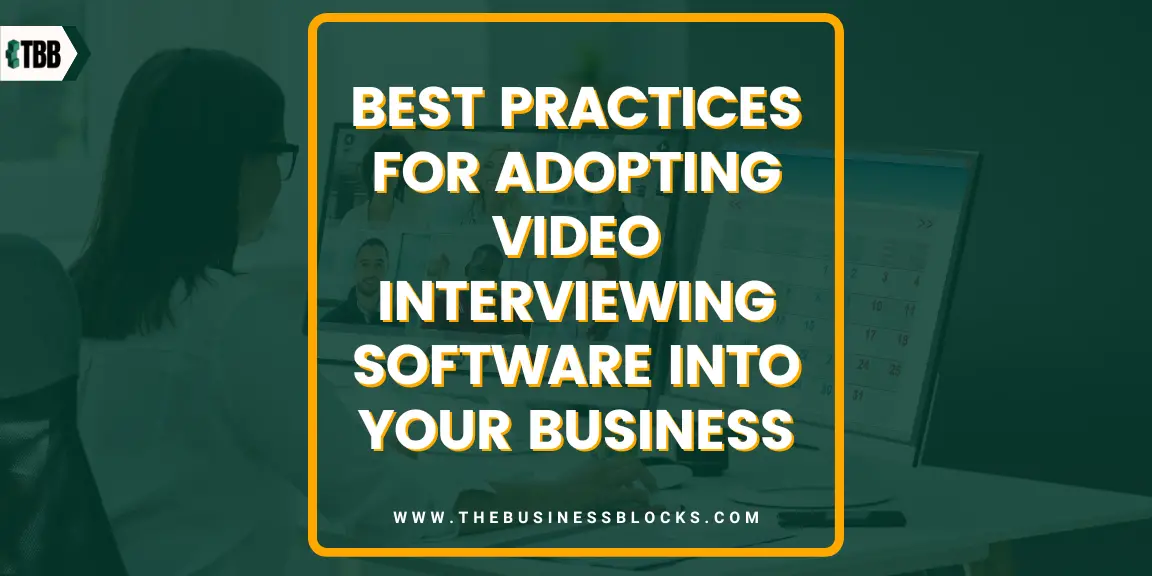Incorporating video interviewing software into your business can significantly enhance recruitment processes and streamline candidate evaluation. To ensure a smooth and successful adoption, it is important to follow best practices that maximize the benefits of this technology.
By implementing the strategies mentioned here, you can seamlessly integrate video interviewing software and optimize its impact on hiring outcomes.
Are you looking to streamline recruitment processes and save time and money?
Video interviewing tool or software is a great way to optimize your business’ recruiting process. This powerful tool helps recruiters make smarter, faster hiring decisions by creating a virtual interview experience for candidates anytime and anywhere. With video interviewing software, you can quickly assess an entire candidate pool without having face-to-face conversations with every single applicant.
Adopting video interviewing software into your business will allow you to spend less time on administrative tasks and more time engaging with potential hires one-on-one. You will be able to create an interactive pre-screening experience that allows each candidate the opportunity to showcase their unique skillsets that otherwise might have gone unnoticed in traditional interviews.
What is Video Interviewing Software, and why should businesses adopt it?

Video interviewing software is a cutting-edge tool that enables businesses to conduct virtual interviews with candidates, transcending geographical limitations. With features like video recording, live streaming, and automated scheduling, the software simplifies the interview process while providing a user-friendly experience. It allows businesses to customize interview templates, set specific questions, and evaluate candidate responses efficiently.
By adopting video interviewing software, businesses can streamline recruitment, overcome logistical challenges, and access a wider talent pool. This modern solution facilitates efficient communication, maintains interview records, and empowers businesses to make informed hiring decisions.
The Benefits of Live Video Interviews and Video Interview Software
The hiring process is about finding the right fit for a job. With video interviewing software, you can easily assess candidates’ communication skills and see how they interact with potential employers. Live video interviews allow recruiters to interact directly with candidates in real-time and better understand who they are, which helps them make more informed decisions.
This modern hiring solution is beneficial in many ways, such as:
- Saving time and money by eliminating the need to travel for in-person interviews
- Offering a convenient, hassle-free way to access remote talent
- Creating engaging pre-screening experiences that make candidates feel at ease
- Facilitating real-time evaluations of skillsets while allowing recruiters to focus on meaningful conversations.
By using video interviewing tools or video interview platform, businesses can assess more candidates in less time and make smarter hiring decisions. If you want to streamline recruitment processes, it’s time to adopt video interviewing software into your business.
Different Types of Video Interviewing Software and Their Pros and Cons

Various types of video interviewing software are available in the market, each offering unique features and benefits. Here are the pros and cons of different types:
Live Video Interviewing:
Pros:
- Real-time interaction and instant feedback.
- Personalized connection and rapport building.
- Allows for spontaneous follow-up questions.
Cons:
- Scheduling conflicts due to coordinating availability.
- Technical glitches or internet connectivity issues.
- Limited flexibility for candidates in different time zones.
Asynchronous Video Interviewing:
Pros:
- Flexibility for candidates to record responses at their convenience.
- Eliminates scheduling conflicts and time zone constraints.
- Enables efficient evaluation by reviewing interviews on demand.
Cons:
- Lack of real-time interaction and immediate feedback.
- Reduced opportunity for building personal rapport.
- Limited chance to ask spontaneous follow-up questions.
AI-Powered Video Interviewing:
Pros:
- Automated analysis of candidate responses for objective evaluation.
- Facial and sentiment analysis for additional insights.
- Efficient screening and shortlisting of candidates.
Cons:
- Reliance on AI algorithms may introduce biases.
- Limited in capturing nuanced responses or non-verbal cues.
- Potential challenges in fine-tuning AI algorithms to specific job requirements.
One-Way Video Interviewing:
Pros:
- Efficient for initial screening of numerous candidates.
- Standardized and consistent interview experience for all candidates.
- Time-saving for both recruiters and candidates.
Cons:
- Lack of real-time interaction and personalized connection.
- Limited opportunity for candidates to showcase their personalities.
- Inability to assess on-the-spot problem-solving abilities.
Each type of video interviewing software has its advantages and disadvantages. The final decision always depends on your needs and preferences.
Developing an Effective Training Program for Video Interviewing Software Users
Implementing video interviewing software in your business requires an effective training program to ensure users can fully leverage its capabilities. Here are key steps to develop a comprehensive training program:
Assess User Needs
Identify specific areas where training is needed, such as navigating the software interface, conducting interviews, and utilizing advanced features.
Create User Guides and Tutorials
Develop user guides, manuals, and video tutorials that provide step-by-step instructions on using the software.
Conduct Hands-On Training
Organize interactive training sessions where users can practice using the software in a simulated environment.
Offer Ongoing Support
Provide ongoing support through a dedicated helpdesk or online support portal.
Promote Best Practices
Educate users on best practices for conducting video interviews, such as creating a professional environment, optimizing audio and video settings, and engaging with candidates effectively.
Encourage Feedback and Continuous Improvement
Establish channels for users to provide feedback on the software, training materials, and user experience.
6 Best Practices for Adopting Video Interviewing Software into Your Business

To successfully adopt video interviewing software into your business, follow these best practices:
1. Evaluate Your Current HR Processes
Assess your existing recruitment processes to identify pain points and areas where video interviewing software can add value. Understand the specific challenges you aim to address and how this technology can streamline your workflows.
2. Research the Types of Software Available
Thoroughly research and compare different video interviewing software options. Consider features, user-friendliness, integration capabilities, security measures, and pricing. Choose a solution that aligns with your business requirements and objectives.
3. Establish Clear Goals and Objectives
Define clear goals and objectives for implementing video interviewing software. Determine your desired outcomes, such as improving time-to-hire, reducing costs, or enhancing the candidate experience. Having defined goals help guide the implementation process.
4. Set Up a Pilot Program for Testing the Software
Before rolling out the software company-wide, conduct a pilot program to test its effectiveness. Select a small group of users to participate and gather their feedback. Use this phase to identify issues, fine-tune processes, and ensure the software meets your expectations.
5. Invest in Quality Training and Support Services
Provide comprehensive training to users on effectively using the video interviewing software. Offer hands-on training, user guides, and access to support resources. Ensure your team understands the software’s functionalities and can utilize them optimally.
6. Regularly Monitor Progress and Make Adjustments as Needed
Continuously monitor the implementation of video interviewing software and its impact on your recruitment processes. Track key metrics, such as time-to-fill and candidate satisfaction, to gauge its effectiveness. Adjust as needed to optimize the software’s usage and achieve desired outcomes.
Preparing to Utilize Video Interviewing Long Term

From one-way video interviews to structured video interviews, video interviewing technology offers many advantages for recruiters and hiring managers. Once implemented, planning and ensuring it can be used long-term is important.
Here are some tips to ensure successful utilization of video interviewing software:
Develop a Comprehensive Video Interviewing Strategy
Organize internal teams to develop a comprehensive strategy that outlines the objectives and usage of the software. Establish protocols for using the software, including interview formats and review processes.
Ensure Data Security and Privacy Compliance
Prioritize data security and ensure compliance with relevant laws like GDPR and CCPA. Invest in robust encryption technologies to protect candidate information.
Introduce Creative Technologies
Leverage advanced technologies like facial recognition or sentiment analysis to gain real-time insights from video interviews.
Invest in Advanced Video Interviewing Platforms
Look for advanced platforms that offer features like AI-assisted interviewing and automated transcriptions. They help streamline the process and provide more accurate insights.
Stay Updated on Emerging Trends in Video Interviewing
Keep abreast of emerging trends in video interviewing to stay competitive and upgrade the software as needed. Look for virtual and augmented reality features that can take video interviewing to a new level.
With an effective training program, best practices in place, and advanced technologies, your organization can maximize the benefits of video interviewing software for job seekers and screen candidates also to utilize it long-term. Leveraging this technology improves recruitment efficiency and enhances the candidate experience.
From panel interviews to best video interviewing practices, video interviewing software allows recruiters to make informed hiring decisions. Start planning your adoption process today and ensure the technology’s long-term success.
Tips for Hiring Team on Conducting Video Interviews

Conducting successful video interviews requires excellent communication, preparation, and follow-through. Here are some tips to help hiring teams have successful video interviews:
1. Prepare for the Interview
Before a video interview, review the candidate’s application materials, job qualifications, and background information. Ensure you understand the position you are interviewing for and come prepared with meaningful questions.
2. Create a Positive Environment
Create an environment that is conducive to having a positive video interview experience. Set up your space with adequate lighting, minimal distractions, good audio equipment, and a professional background.
3. Stay Engaged During the Interview
Stay engaged during the Interview by maintaining consistent eye contact and encouraging body language. Keep the conversation flowing with open-ended questions, active listening, and thoughtful follow-ups.
4. Provide Clear Instructions
Provide clear instructions to candidates on accessing the video interview platform, completing technical checks, and locating supplemental materials. Ensure your expectations for the virtual Interview are communicated so they can be successful.
5. Follow Up with Candidates.’
After the video interview, follow up with candidates promptly to inform them of the next steps. This shows courtesy and respect for their time and efforts in interviewing with you.
6. Provide Constructive Feedback
Where appropriate, provide constructive feedback to candidates after the Interview on areas of improvement. This helps them in their job search journey and reflects positively on your organization.
7. Leverage Video Interviewing Software Features
Leverage the features of video interviewing software, such as screening questions, automated notifications, and lem-solving abilities, to streamline your process and maximize efficiency. With the right training and best practices, you can utilize video interviewing software to optimize your recruitment process and enhance the candidate experience.
By following these steps and tips, you can successfully integrate this technology into your organization and get the most out of it. These on-demand video interviews can make recruitment easier, faster, and more efficient. With the right training and best practices, you can utilize video interviewing software to optimize your recruitment process and enhance the candidate experience.
Frequently Asked Questions About Best Practices for Adopting Video Interviewing Software into Your Business\
Q: What are the best practices for adopting video interviewing software into my business?
A: Evaluating current HR processes, researching available software, establishing clear goals, conducting a pilot program, investing in training and support, and monitoring progress regularly.
Q: How can video interviewing software enhance the recruitment process?
A: Video interviewing software enhances the recruitment process by streamlining workflows, improving candidate evaluation, reducing time-to-hire, and enhancing candidate experience.
Q: What factors should I consider when selecting video interviewing software?
A: Software features, user-friendliness, integration capabilities, security measures, and pricing.
Q: How can I ensure a successful adoption of video interviewing software?
A: To ensure successful adoption, it is important to conduct thorough research, provide quality training and support, set clear goals, conduct pilot testing, and regularly monitor progress.
Q: Can video interviewing software completely replace traditional in-person interviews?
A: While video interviewing software offers many benefits, it is typically used to complement traditional in-person interviews rather than a complete replacement.
Conclusion
Adopting video interviewing software into your business is a great way to streamline recruitment and make hiring more effective. Video interviewing technology connects employers with talented candidates quickly and efficiently, eliminating geographic boundaries. With these best practices in mind –from enabling engagement with specific questions to personalizing the interviews– businesses can ensure their recruiting process is as successful as possible.
However, this success largely depends on finding the right video interviewing software for your business needs. Do your research before investing in a particular platform; look at its features, customer support ratings, demo version availability, and more to ensure it’s truly suitable for your organization.
Ultimately, if done right, video interviewing can potentially improve hiring outcomes at every business and should be seriously considered when taking the recruitment process forward. We hope our guide helps you adopt the best practices for adopting and benefiting from video interview tools.

